Chicken feather patterns with breed examples, pictures and video.
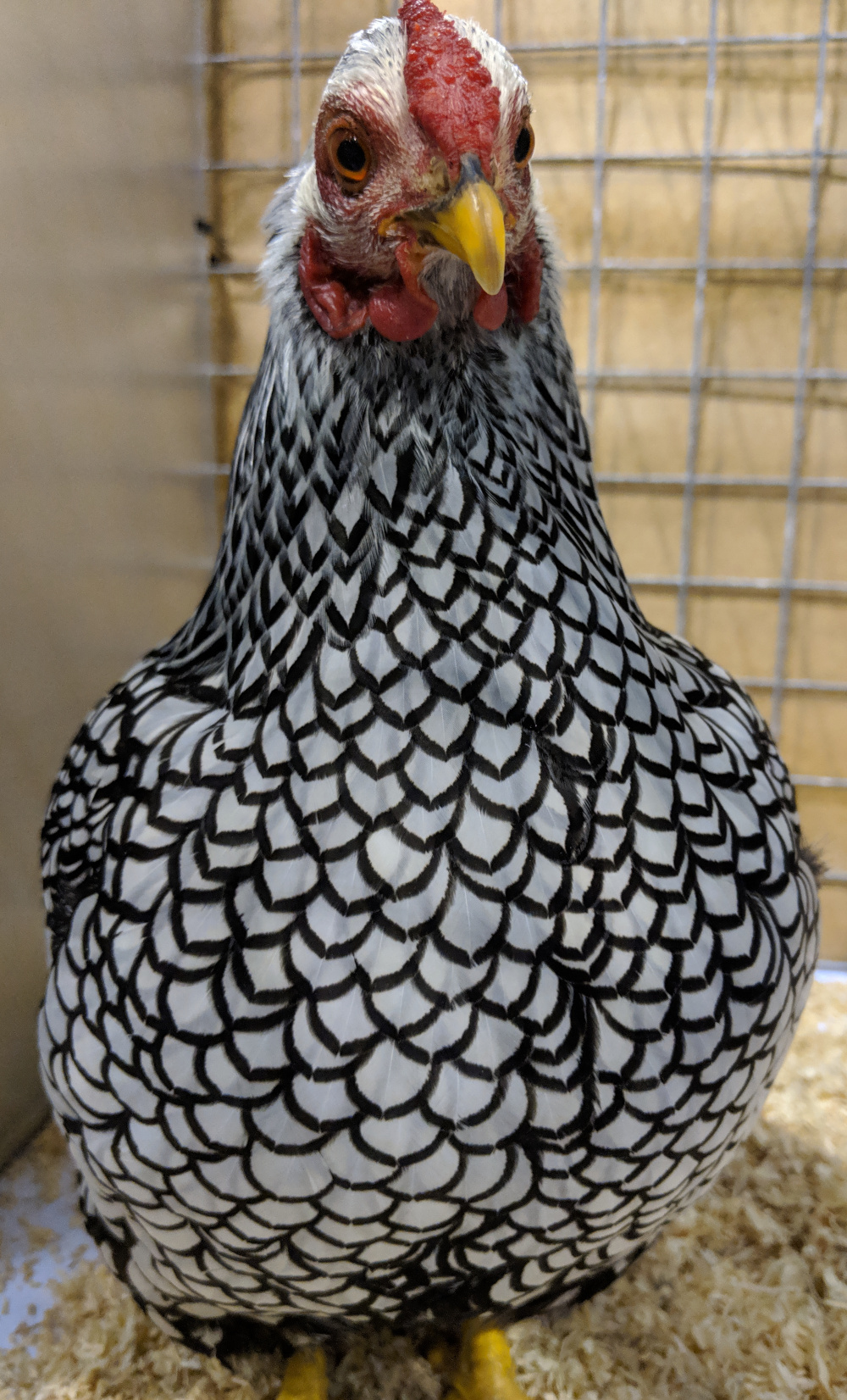
This is a very picture and video heavy page.
Table of Contents
- What are feather patterns?
- How many feather patterns are there in chickens?
- Barring or barred feather pattern:
- Lacing or Single laced feather pattern:
- Double laced feathering:
- Spangled feather pattern:
- Colombian feather pattern:
- Crele Feather pattern:
- Cuckoo feathers:
- Mottled feathers:
- Mille Fleur or Jubilee feathering:
- Pencilled or Partridge feather Pattern:
- Splash feather pattern:
- Exchequer feather pattern:
- No feather patterns or solid colour:
- Plumage pattern differences in male or female chickens:
What are feather patterns in chickens?
Feather patterns in chickens are the unique and distinct markings on the feathers made up of lacing, trims, lines, bars or spots. This diverse patterning of the feathers has been produced by hundreds of years of selective breeding by chicken fanciers.
The arrangement of these patterns helps to define the breed.
How many feather patterns are there in chickens?
There are 14 feather patterns in chickens:
- Barred,
- Laced,
- Double laced,
- Colombian (sometimes called ermine pattern),
- Pencilled or partridge,
- Spangled,
- Crele,
- cuckoo
- Mottled,
- Mille Fleur or Jubilee,
- Splash,
- Exchequer,
- No pattern or solid colour.
Some patterns are specific to certain breeds, the Exchequer is specific to leghorns for example.
Barring or barred feather pattern:
The barred feather pattern consists of black and white stripes on the feather. The best examples have the most even colouring with the bars being the same thickness.
Barred feathers should have a beetle sheen on the black part of the feather and the colours should be well defined with sharp edges.
Barred breed examples include the Barred Rock, the Dominique and the Scots Grey.
Below: A barred rock hen, you can clearly see the alternating black and white bars on the feathers.

The barring gene is sex linked and can be used to produce auto-sexing chickens.
Lacing or Single laced feather pattern:
The single laced feather has a uniform black, white or blue line around the outside of a coloured feather. Single lacing ground colours include white, blue, gold and lemon.
The more even the ground colour and the black border across the feathers the better the pattern.
The white bordered single laced feather is sometimes called Chamois and is mostly found in Polish chickens.
Below: The chamois polish. The ground colour is brown and the single lacing around the edge of the feather is white.

Below: A gold laced Sebright hen with stunning single laced feathers.
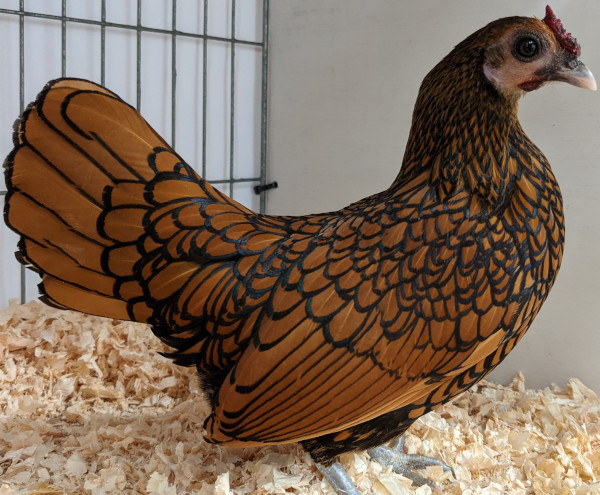
Breed examples with a single laced feather pattern include gold laced Wyandotte, the blue laced Barnevelder, the silver laced Polish and the lemon Sebright.
Below: An example of a blue laced red Wyandotte where the black lacing on the feather border has been replaced with blue.
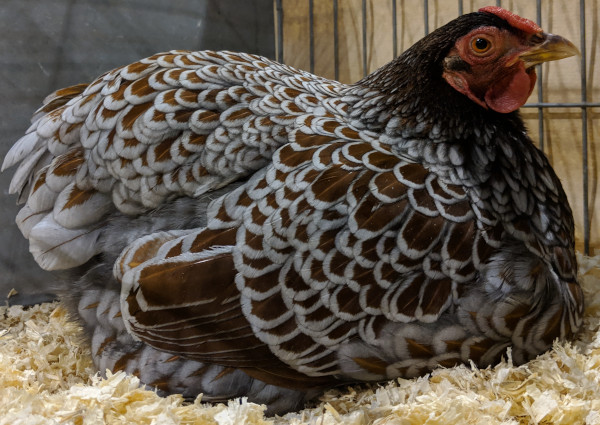
Hens show the lacing better than cockerels, the latter only has lacing on the chest feathers.
Double laced feathering:
The double laced feather pattern has a second line in addition to the coloured border of the feather.
Laced feathers feature thicker lines that will go all the way around the outside of the feather.
Below: The best known double laced chicken is probably the Barnevelder, here is a silver laced example.
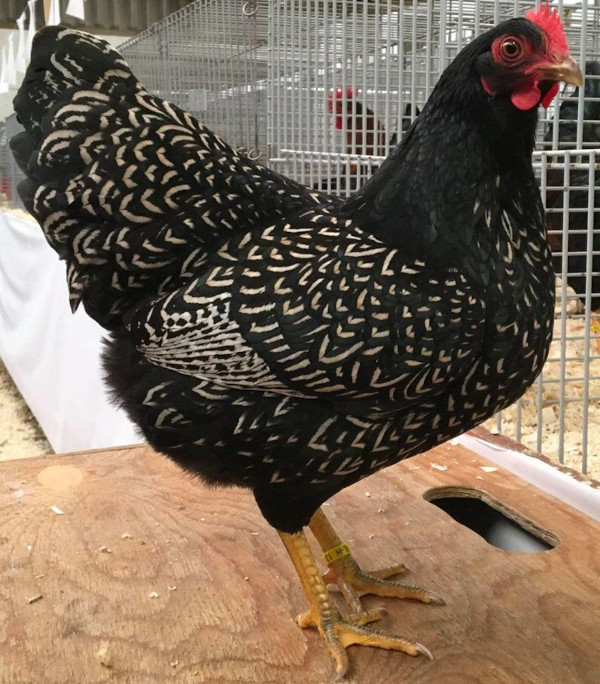
I have been breeding double laced Barnevelders for years now and they are just stunning.
Breed example for the double laced feather pattern include the
Spangled feather pattern:
Spangled plumage is a completely white feather with a black stripe across the base and a black tip. Spangled and mottled are opposites of each other.
Below: Ideal spangled feathers from an old poultry book.
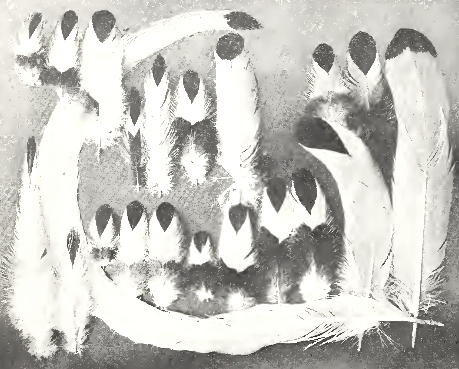
The ideal spangled feather pattern is a completely white feather with a triangular tip and clean black base to the feather. The more even the shape and colour the better and excessively large or small white tips are to be avoided.
Below: The spangled feather pattern on a hamburg.
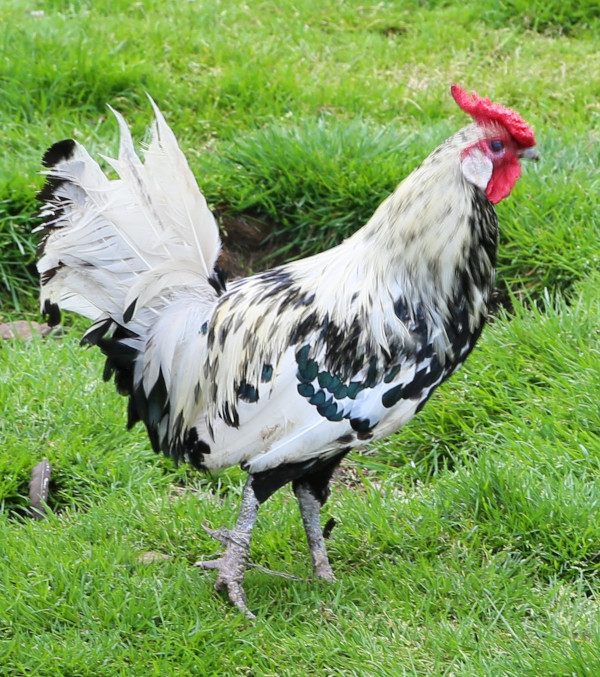
Breeds with spangled feather pattern include the Spangled Hamburg.
Colombian feather pattern:
The Colombian feather pattern ( historically called Ermine) has a ruff of black feathers around the neck and a black tip tho the tail and both wing tips. The black neck and wing feathers are edged in a thin white line which served to provide definition to the feathers.
The ideal Colombian is a deep and even ruff and large clearly defined wing tips and tail.
Below: The Light Sussex is a good example of the Colombian feather pattern.
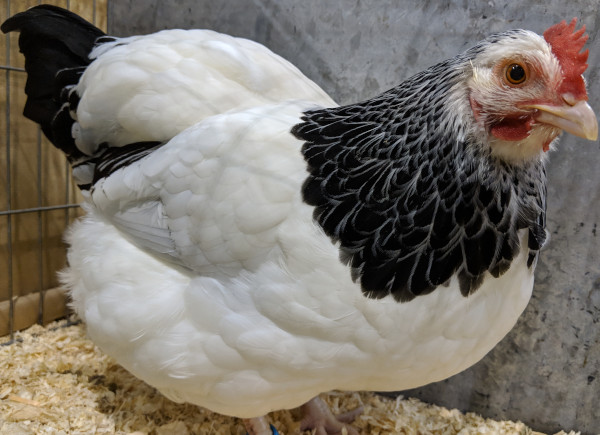
Below: When the Black in the Colombian feather pattern is replaced with Gray it is called Coronation.
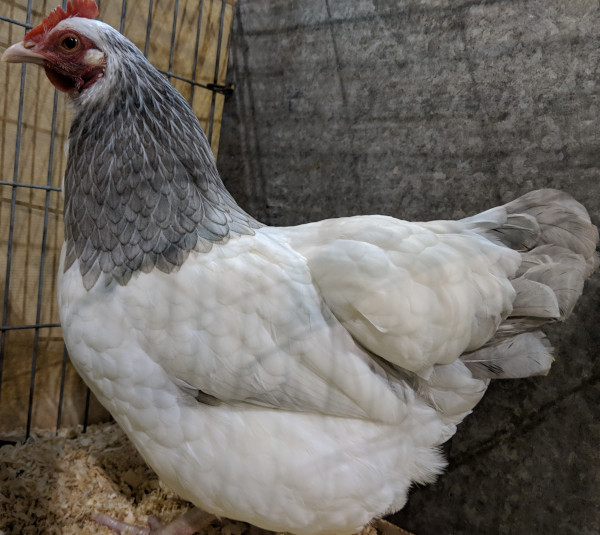
Breed examples with the Colombian feather pattern include Light and Buff Sussex and the New Hampshire Red.
Crele Feather pattern:
Crele is a type of barring and is sex linked.
The Crele feather pattern is barring over black breasted red. True Crele is black breasted red as a base colour.
The ideal Crele pattern is even barred marking, the more clearly defined the better. The genetics of the Crele mean that the darker bands are generally thicker than the lighter markings.
Below: A crele Pekin bantam showing the feather pattern clearly.

Breed examples of the Crele feather pattern include the Pekin, the Orpington and the Polish.
Cuckoo feathers:
Barred and Cuckoo seem to be similar at first glance but they are different. Cuckoo feathers do have the clear Zebra lines of the barred feather pattern.
Below: A close up video of the cuckoo feather pattern.
The difference between cuckoo and barred feather pattern is the definition in the colour borders. Barred feathered chickens have a crisp lines between the colour on the feathers and Cuckoo feathers appear much more smudged and are darker.
Below: A cuckoo Pekin. You can see the white lines are smudged into the black.
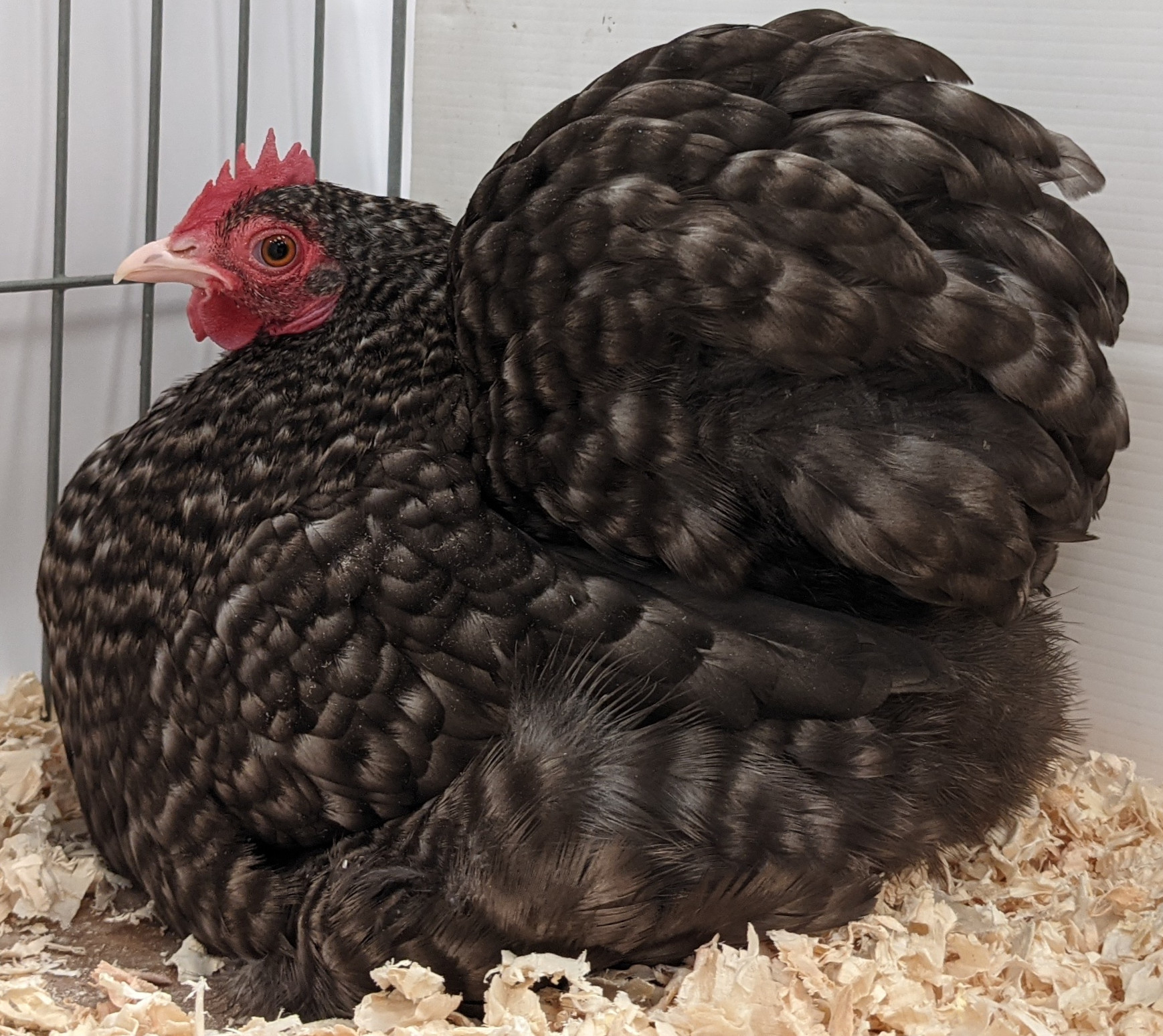
In both the barred and the Cuckoo feather pattern you can have one or two copies of the barring gene. Two copies of the gene means wider bars and a single copy means narrower bars across the feathers.
Breed examples of the cuckoo feather pattern include the Pekin, Marans, Silkie and Polish.
Mottled feathers:
Mottled feathers are all black with a stark white V tipping on a glossy greenish - black ground colour.
The feathers should be evenly mottled with white at the tip of each feather on a rich black with beetle-green sheen.
The mottle is a black feathered fowl with dark under-colour and an even distribution of white, being a white tip to each feather.
Below: The mottled feather pattern on an Ancona chicken.
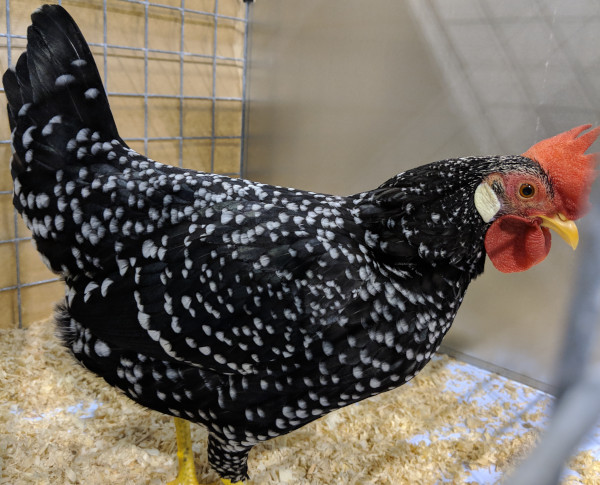
Mottling changes with every moult and getting the best results require years of patient breeding. Other faults in mottling include smearing and streaking where the colour blends in or runs in some feathers.
Below: A selection of mottled feathers from a poultry standards book.
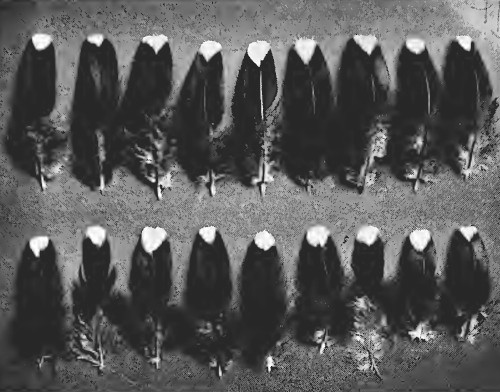
Pearl is also another colour with mottling the bird is genetically a black mottled bird that also carries the lavender gene so you get a lavender bird with white mottles.
Mille Fleur or Jubilee feathering:
The literal translation of Mille Fleur is "thousand flowers."
Mille fleur have a chestnut or mahogany ground colour with each feather containing a black crescent pattern with a silver tip. The markings should be well defined and equal in consistent in size across the chicken.
Below: A Jubilee or Mille Fleur feather pattern.
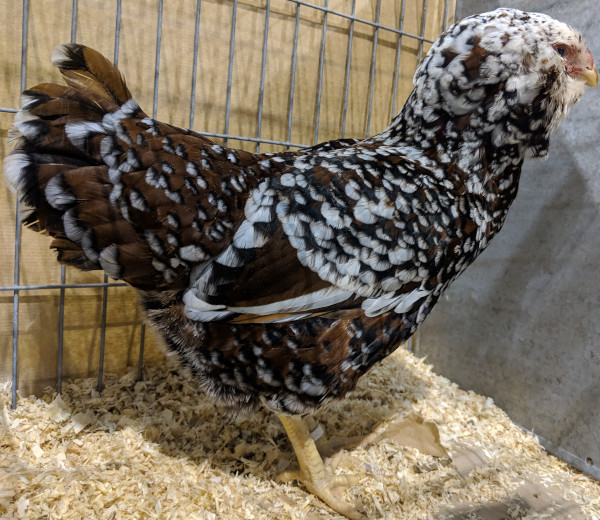
Jubilee and Mille Fleur are genetically the same, the English call it Jubilee and the French would call it Mille Fleur .
This feather patterns changes with every moult and gradually white becomes more dominant.
Below: A video of a jubilee Orpington.
Pencilled or Partridge feather Pattern:
Pencilled or partridge feathers resemble laced plumage but the lines are thinner and they don’t lace the outside of the feather.
With pencilled plumage, the lines are much thinner and while they follow the contour and shape of the feather but don’t trim the outside edge of it.
Examples of pencilled chicken breeds include the silver or gold pencilled Wyandottes or the pencilled Cochin.
Below: A gold pencilled Wyandotte bantam.
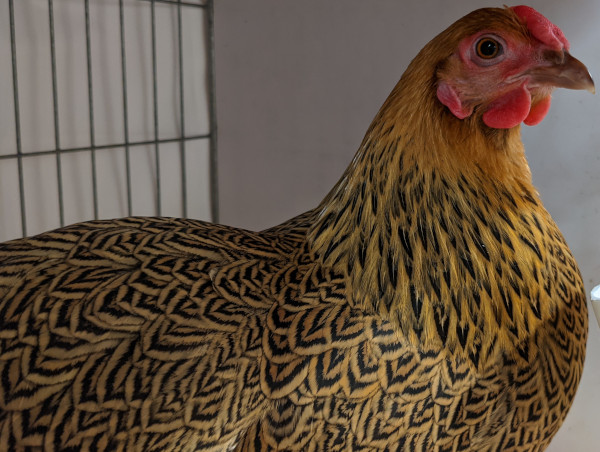
People often think of pencilling as triple lacing as there are three lines but the colours are reversed from lacing and the ground colour trims the outside of the feathers.
The Partridge feather pattern is the same as pencilled and there may be more than 3 bands on the feathers or sometimes a black line up the quill.
Below: A partridge Silkie.
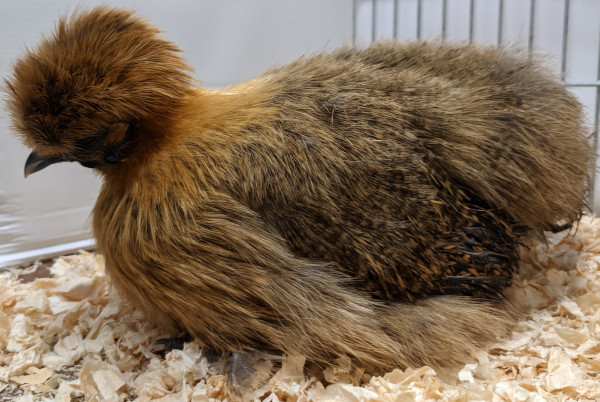
Splash feather pattern:
The splash feather pattern consists of a white ground colour with uneven spots of blue or black randomly scattered over the chicken. The spots can be blue, black or Gray and are uneven in size and shape.
Below: A splash feathered Rosecomb bantam.
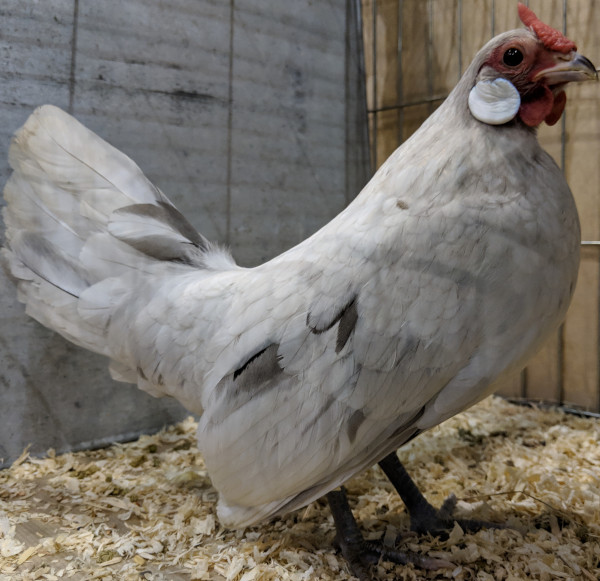
Splash feathering is difficult to breed properly and evn colouring is the desired effect.
Splash feather pattern breeding chart:
Blue X Blue = 50% Blue, 25% Black , 25% Splash
Blue X Splash = 50% Blue , 50% Splash
Blue X Black = 50% Blue, 50% Black
Black X Black = 100% Black
Splash X Black = 100% Blue
Splash X Splash = 100% Splash
Splash feathering comes about because the gen for blue is recessive but not completely.
Exchequer feather pattern:
The exchequer is a black and white fowl with even distribution of black and white in a random pattern, the black and white to be as evenly distributed when viewed from any angle.
Mottled tends toward being nice round patches of white on the tip of the feather whilst exchequer is uneven.
Below: The Exchequer feather pattern.
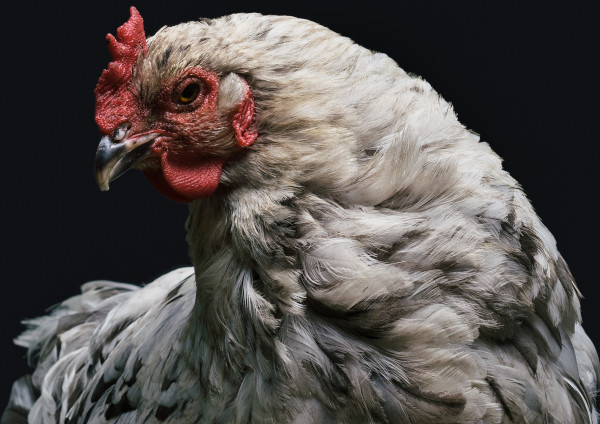
The whole idea is it is to resemble a chequer board, even black and white, not a black fowl tipped with white. Both colours become whiter or more Gray as they get older.
No feather patterns or solid colour:
Chickens with solid colour have no feather patterns at all.
Plumage pattern differences in male or female chickens:
Plumage patterns differ between the sexes in almost all chickens.
The exception to this rule is Hen feathered breeds like the Sebright.
Below: The plumage pattern in the male as a pen and ink drawing.
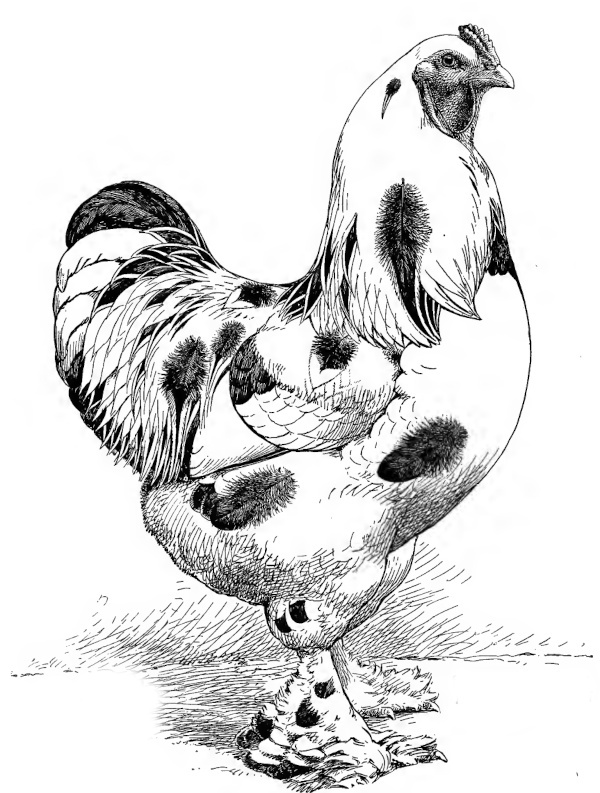
Below: The hen pattern and locations on the hens.
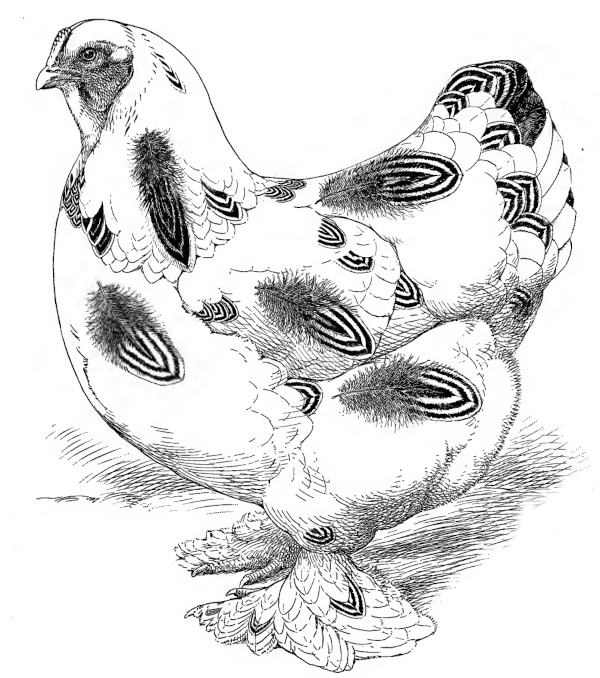
The feather pattern is often more visible on the females.
Below: This picture plate shows the difference between the feather shape of the cockerels and hens.

